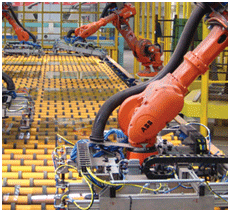 With innovation being a major aspect in the developing world, technologies are changing & being upgraded day by day and thus is the use of critical components, such as encoders. Encoders have become a vital source for many applications requiring feedback information. Whether an application is concerned with speed, direction or distance, an encoder’s vast capability allow users to utilize this information for precise control. With the emergence of higher resolutions, ruggedness & lower costs, encoders have become the preferred technology in more and more areas. Today, encoder applications are all around us.
With innovation being a major aspect in the developing world, technologies are changing & being upgraded day by day and thus is the use of critical components, such as encoders. Encoders have become a vital source for many applications requiring feedback information. Whether an application is concerned with speed, direction or distance, an encoder’s vast capability allow users to utilize this information for precise control. With the emergence of higher resolutions, ruggedness & lower costs, encoders have become the preferred technology in more and more areas. Today, encoder applications are all around us.
The situation has changed considerably over the last few years. Just as incandescent indicator lamps have been replaced by long-life LEDs, the glass disks have been replaced by steel and plastic disks, the encoder electronics are more integrated and thus more durable for heavy duty applications. Encoder is an electro-mechanical device that converts the angular position or motion of a shaft or axle to an analog to digital code.
Absolute & Incremental Encoder
Encoders are basically of two main types: absolute and incremental (relative). The output of absolute encoders indicates the current position of the shaft, making them angle transducers. The output of incremental encoders provides information about the motion of the shaft, which is typically further processed elsewhere into information such as speed, distance and position.
The major difference between an absolute encoder and an incremental encoder is that the absolute encoder keeps track of its position at all times, and provides it as soon as power is applied. This feature is particularly useful in applications where the equipment runs infrequently and/or has power turned off between uses. Incremental encoders, by comparison, does not provide any position information at start-up, but merely keeps track of how far it has moved. The only way to determine the absolute position of incremental encoders is to set the equipment to a known reference position and then zero the counters.
Advantages of Scancon Encoders
- Act as a complete solution between meter and computer
- Can be interfaced easily to modern control systems, i.e. they are inherently digital
- Eliminates the need of engineer to get involved in the wiring and integration of signal electronics
- Spot-on digital output allows for more accurate speed control than is available from an analog tachometer
- Has longer life as they are void of the analog tach’s brushes
- Largest range of ATEX & Ex encoders for explosion proof applications
Encoders are used in many industries
 Encoders have become an essential component to many applications in different industries. Mentioning here a partial list of Scancon encoders application.
Encoders have become an essential component to many applications in different industries. Mentioning here a partial list of Scancon encoders application.
Robotic applications : Pick’n place machines, Testing machines, Medical
Automated machinery: Food and beverage, Clinical, Rig control & Commercial painting enclosures, Cable drum, Paper machines, Conveyor belt, Sewing machines, Hydraulic machines
Renewable energy: Solar panels, Positioning mirrors, Wind turbine generator, YAW controller box, Pitch controller box, Pitch drive motor, Sleeve ring control, Gear drive control
Telecom: Satellite disk outdoor, Radar, Communication disk, Digital Tracking Pedestal System, Huge Disk
Industrial: Mining, Oil production, Wind energy, Generator, Motor, Oil dispenser, Glass shaft machines, Crane, Tanker ships, Fishing ship, Elevators, Traction Motors, Instrumentation
Airport: Fueling system, Hangar doors, Passenger boarding bridge
Defence & Space: Radar, Marine, Submarine
Explosion Proof Applications: Chemical, Painting automobile, PD-meters, Fuel dispenser, LNG, LPG, Mining, Drilling, Oil & Gas







